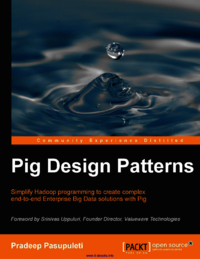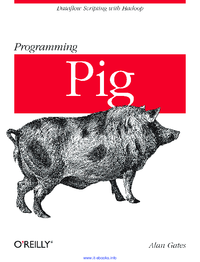Etiqueta "Pig"
Se han encontrado 2 Coincidencias
Pig Design Patterns
Pig Design Patterns
49 Visitas | 67 Descargas | 2015-11-27 16:46:36 | pecarrazana
The Pig platform surely is one of these methods. Nevertheless, the power of such a platform is best tapped by extending it efficiently. Extending requires great familiarity of the platform. More importantly, extending is fun when the process of building such extensions is easy. The Pig Latin platform offers great simplicity. However, a practitioner's advice is immensely valuable in leveraging this simplicity to an enterprise's own requirement. This is where I find this book to be very apt. It makes you productive with the platform pretty quickly through very well-researched design patterns. This helps simplify programming in Hadoop and create complex end-to-end enterprise-grade Big Data solutions through a building block and best-pattern approach. This book covers the journey of Big Data from the time it enters the enterprise to its eventual use in analytics, either in the form of a dashboard or a predictive model.

Programming Pig
Programming Pig
70 Visitas | 66 Descargas | 2015-11-27 16:48:20 | pecarrazana
This book is intended for Pig programmers, new and old. Those who have never used Pig will find introductory material on how to run Pig and to get them started writing Pig Latin scripts. For seasoned Pig users, this book covers almost every feature of Pig: different modes it can be run in, complete coverage of the Pig Latin language, and how to extend Pig with your own User Defined Functions (UDFs). Even those who have been using Pig for a long time are likely to discover features they have not used before. Being a relatively young project, Pig has changed and grown significantly over the last four years. In that time we have released versions 0.1 through 0.9. This book assumes Pig 0.7 as the base version. Wherever features are only in versions 0.8 or 0.9, this is called out. The biggest change from 0.6 to 0.7 is that load and store function interfaces were rewritten, so Chapter 11 will not be usable by those on 0.6 or earlier versions. However, the rest of the book will still be applicable. Some knowledge of Hadoop will be useful for readers and Pig users. Appendix B pro- vides an introduction to Hadoop and how it works. “Pig on Hadoop” on page 1 walks through a very simple example of a Hadoop job. These sections will be helpful for those not already familiar with Hadoop. Small snippets of Java, Python, and SQL are used in parts of this book. Knowledge of these languages is not required to use Pig, but knowledge of Python and Java will be necessary for some of the more advanced features. Those with a SQL background may find “Comparing query and dataflow languages” on page 4 to be a helpful starting point in understanding the similarities and differences between Pig Latin and SQL.
Contribuir
Usted puede contribuir con Libros UCLV, es importante para nosotros su aporte..
Contribuir